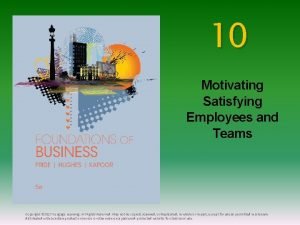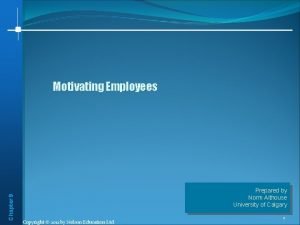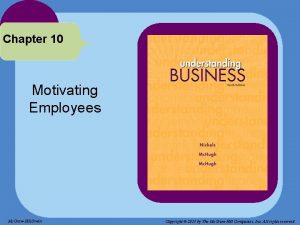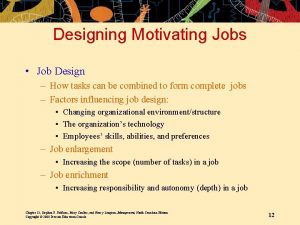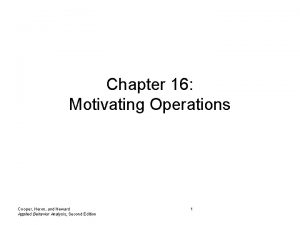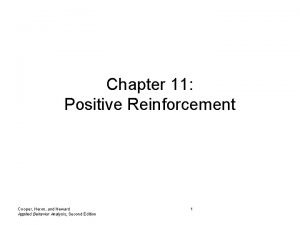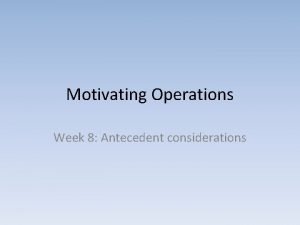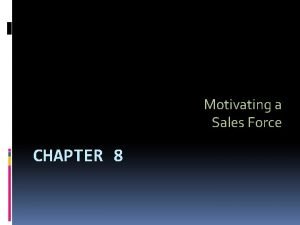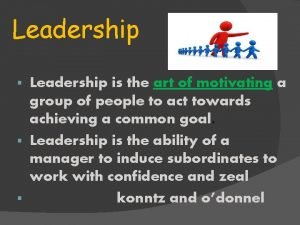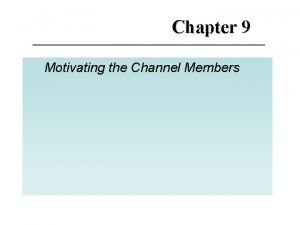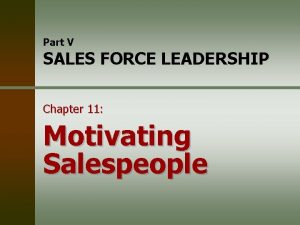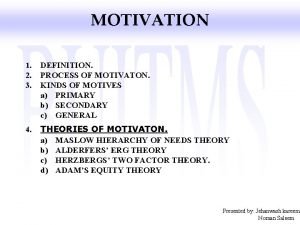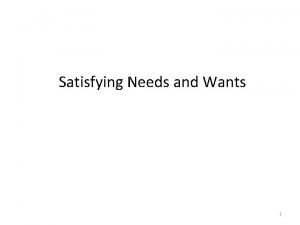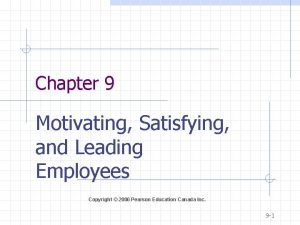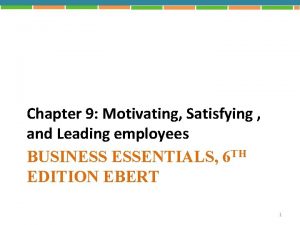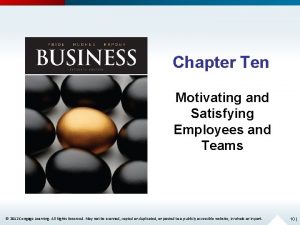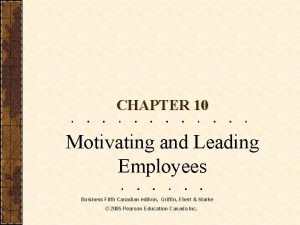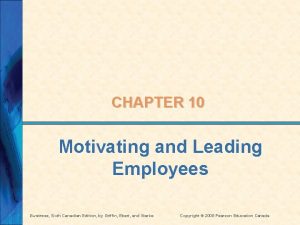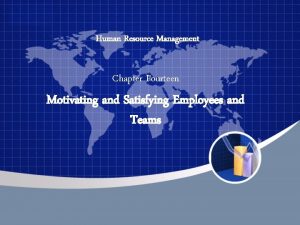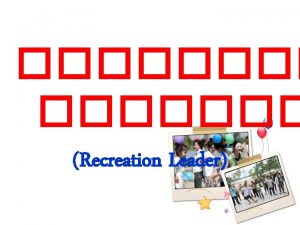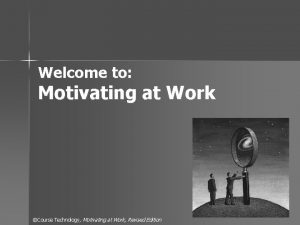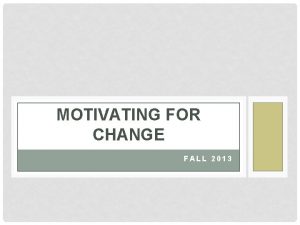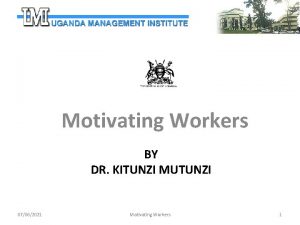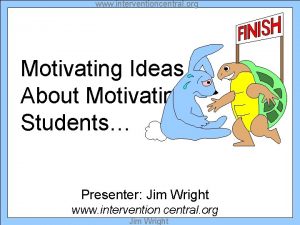Motivating Satisfying and Leading Employees A leader is



































- Slides: 35

Motivating, Satisfying, and Leading Employees

“A leader is best when people barely know he exists, when his work is done… they will say: We did it ourselves. ” ~ Lao-Tzu, c. 600 B. C. “Leadership is the art of getting someone else to do something you want done because he wants to do it. ” ~ Dwight D. Eisenhower, 1890 - 1969

Key Topics � � � Psychological contracts in the workplace Job satisfaction and employee morale Theories of employee motivation Job satisfaction and employee motivation Managerial styles of leadership

Psychological Contract A Set of Employment Expectations Contributions: What does each employee expect to contribute to the organization? Inducements: What will the organization provide to each employee in return?

Satisfied Employees Are More Productive and More Committed Low Turnover: A low percentage of employees leave each year TURNOVER An overall positive employee attitude toward the workplace MORALE High Morale: TURNOVER Degree of enjoyment employees derive from doing their jobs MORALE Job Satisfaction:

Fortune Magazine’s 100 Best Companies to Work For “It's not easy being good these days at least if you're an employer. ” � Edward Jones #1 � Cisco Systems #15 � Microsoft #28 � Patagonia #41 � Starbucks #58 � Wal-Mart #94 Source: Fortune Magazine, February 4 th, 2002

Highly Motivated Employees Are Critical to Business Success Motivation: The set of forces that cause people to behave in certain ways § Classical § Behavior: The Hawthorne Studies § Contemporary

The Human Resources Model Theory X and Theory Y Theory X § People are lazy. § People lack ambition and dislike responsibility. § People are selfcentered. § People resist change. § People are gullible and not very bright. Theory Y § People are energetic. § People are ambitious and seek responsibility. § People can be selfless. § People want to contribute to business growth and change. § People are intelligent.

� � � Content Motivational Theories 1. Maslow’s Hierarchy of Needs 2. Alderfer’s ERG Needs 3. Herzberg’s twofactor theory 4. Mc. Clelland’s Achievement Motivation � � Process Motivational Models 1. Vroom’s Expectancy Theory 2. Adam’s Equity Theory 3. Skinner’s Reinforcement Theory

Maslow’s Hierarchy of Needs General Examples Status Self. Actualization Needs Esteem Needs Friendship Social Needs Social Self-Fulfillment Stability Security Needs Shelter Physiological Needs Organizational Examples Challenging Job Title Friends at Work Pension Plan Salary

Two Factor Theory Hygiene Factors Motivation Factors • Supervisors • Achievement • Working Conditions • Recognition • Interpersonal Relations • The Work Itself • Pay & Security • Responsibility • Company Policies & Administration • Advancement & Growth Dissatisfaction Satisfaction

Expectancy Theory Individual Effort Individual Performan ce Effort. Performanc e Issue Organizatio nal Rewards Performanc e-Reward Issue Personal Goals Rewards. Personal Goals Issue

Equity Theory Employees evaluate their treatment relative to the treatment of others Inputs: Employee contributions to their jobs Outputs: What employees receive in return The perceived ratio of contribution to return determines perceived equity

Strategies for Enhancing Job Satisfaction and Morale ê Reinforcement/behavior modification ê Management by objectives ê Participative management and empowerment ê Job enrichment and job redesign ê Modified work schedules

Skinner’s Reinforcement / Behavior Modification Theory Punishment When negative consequences are attached directly to undesirable behavior Positive Reinforcement When rewards are tied directly to performance

Alderfer’s ERG Theory









Management by Objectives Collaborative Goal-setting Collaborativ e Goal Setting & Planning Communicati ng Organization al Goals & Plans Meeting Setting Verifiable Goals & Clear Plans Counseling Identifying Resources Periodic Review Evaluation

Participative Management and Empowerment � Increasing job satisfaction by encouraging participation � Team management represents a growing trend

Job Enrichment and Job Redesign Job Enrichment: Adding one or more motivating factors to job activities Job Redesign: Designing a better fit between workers and their jobs � Combining tasks � Forming natural work groups � Establishing client relationships

Modified Work Schedules � Work share programs � Flextime programs and alternative workplace strategies � Telecommuting and virtual offices

Sample Flextime Scheduling 6: 00 7: 00 8: 00 9: 00 10: 00 11: 00 12: 00 1: 00 2: 00 3: 00 4: 00 5: 00 6: 00 A. M. Flexible Time Joe Sue Pat A. M. Core Time A. M. NOON Flexible Time P. M. Core Time P. M. Flexible Time P. M.

Evaluating Modified Schedules and Alternative Workplaces Advantages Disadvantages � More satisfied, committed employees � Challenging to coordinate and manage � Less congestion � Poor fit for some workers

Managerial Leadership The process of motivating others to work to meet specific objectives

Five Fundamental Leadership Practices ê Challenge the process ê Inspire a shared vision ê Enable others to act ê Model the way ê Encourage the heart Source: www. theleadershipchallenge. com

Leadership at General Electric “Four E’s of GE Leadership” � A high energy level � The ability to energize others around common goals � The edge to make tough decisions � The ability to consistently execute and deliver on promises Source: Jack Welch Tells It Straight from the Gut, Anderson Assets, Winter 2002

Managerial Styles Autocratic Style Democratic Style Free-rein Style Contingency Approach The appropriate style in any situation is contingent on the unique elements of that situation

Motivation and Leadership in the Twenty-first Century Motivation Security and pay are no longer enough Leadership ê ê ê “Coach” mentality Diversity Flexibility
 Motivating and satisfying employees and teams
Motivating and satisfying employees and teams Motivating and satisfying employees and teams
Motivating and satisfying employees and teams Is the individual internal process that energizes directs
Is the individual internal process that energizes directs Motivating and satisfying employees and teams
Motivating and satisfying employees and teams Copyright
Copyright Leading and motivating a team
Leading and motivating a team Herzberg’s two-factor theory
Herzberg’s two-factor theory Motivating employees without money
Motivating employees without money Chapter 10 motivating employees
Chapter 10 motivating employees Chapter 10 motivating employees
Chapter 10 motivating employees Chapter 10 motivating employees
Chapter 10 motivating employees Objectives of roving frame
Objectives of roving frame Transactional leadership
Transactional leadership Motivating yourself and others
Motivating yourself and others Motivating parallelism
Motivating parallelism How to motivate esl students
How to motivate esl students Designing motivating jobs
Designing motivating jobs Cmo-t examples
Cmo-t examples Pre task choice aba
Pre task choice aba Motivating operations definition
Motivating operations definition Sales force motivation theories
Sales force motivation theories Leadership is the art of motivating a group
Leadership is the art of motivating a group Channel motivation
Channel motivation Planning organizing motivating staffing
Planning organizing motivating staffing Motivation for software developers
Motivation for software developers Motivating parallelism
Motivating parallelism Poor maps and navigational tools
Poor maps and navigational tools Motivating people for total quality
Motivating people for total quality Methods of sales force motivation
Methods of sales force motivation Iglr assessment
Iglr assessment What evidence is there of aldi motivating its workforce
What evidence is there of aldi motivating its workforce Motivating parallelism
Motivating parallelism Want satisfaction chain
Want satisfaction chain Directing and staffing
Directing and staffing Motivating example
Motivating example Satisfying needs 1
Satisfying needs 1




